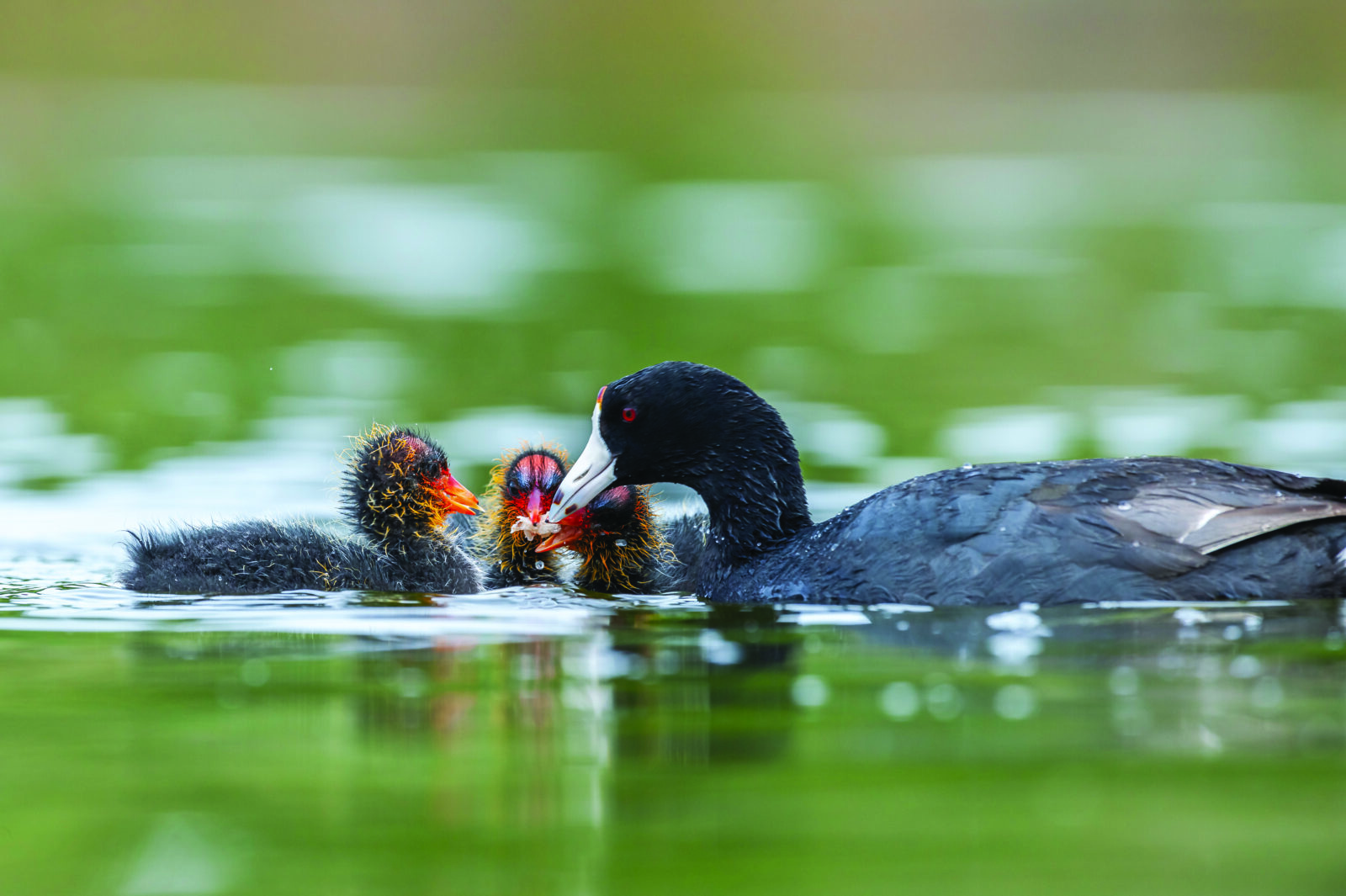
One of the commonest birds on the shoreline has a soap opera for a home life. American coots (Fulica americana) look like black-tie ducks, with white beaks and red eyes, though they’re actually rails. Ably they chug across the water, probably away from you, with their weird scalloped claw-feet working below. UC Santa Cruz professor Bruce Lyon studies them in British Columbia wetlands, where coots breed usefully densely among the reeds. Lyon watches them from as close as five feet, inside shaggy fake muskrat nests made to fool the coots. For years Lyon has been sorting out the dynamics behind their dramas.
But back to the feet: built for battle as well as paddling. Males fight with males, females with females. Two birds face off on the water, leaning back like kangaroos to bring up sharp talons from below. Splashing ensues, and sometimes blood: this is no ritual chest-thump but a real row. Chicks on the sidelines peep their hearts out, “like a family feud,” Lyon says. Coots fight for territory, which is about food—pond muck, insects. Stakes are high. In B.C., typically half of the chicks die, mostly from starvation. After the fights come peace pirouettes.
The chicks are what got Lyon to start studying coots. They hatch, starting in late spring in the Bay Area, as bright red-and-orange fuzzy firecrackers with blue eyebrows, flamboyant as peacocks. Upon first seeing them, Lyon wondered: Why? It can’t be the peacock answer of sexual selection. Please! They’re too young for that. It’s also not the “I’m poisonous” of caterpillars. Eventually, Lyon and colleagues found it’s more a way to charm their parents into feeding them.
It’s linked to a weird thing coots do. Unlike most birds, coots do not wait until all their eggs are laid to start incubating them. They get right on that nest around Day 3 and keep laying as they go. As a result chicks hatch asynchronously over an average of five days. Why coots do this is a puzzle, but it shapes the household dynamic.
The first week or so of family life is pretty calm while everybody hatches. The chicks are buoyant fluffballs, wholly reliant on their parents for food (unlike, say, self-sufficient ducklings). Around Day 10, Mom and Dad divvy up their nine or so offspring, each taking responsibility for feeding their lot. That’s when things get violent.
Older chicks can swim faster to dinner, which is first come, first served. But parents mete out justice to the early arrivals. Mom takes a big chick by the head in her bill and shakes it around like a dog with a rope—an act called “tousling” that doesn’t quite communicate its vigor. Lyon calls it “spanking.” The chicks “scream blue murder,” but punishment is calibrated to deter without harming them, Lyon says. This way smaller chicks get to eat, and more chicks survive overall.
The colors, Lyon found, even the playing field, by helping parents tell the younger from the older kids. It is mama coot’s doing: In each egg’s yolk, she deposits more carotenoids than in the last, brightening her youngest babies the most.
Coot parents can distinguish not only among their own children but also theirs from those of other coots. This serves them well, because their fellow coots are notorious for laying eggs in neighboring nests to get free child-rearing. (“Eggs are cheap,” Lyon has written.) When coots recognize foreign eggs, they may push them into the depths of the watery nest, where the leeches live. When coots recognize parasitic chicks, they kill them. As with the hatching asynchrony, this brood parasitism isn’t unique among birds—coots just take it to eleven.
Lyon and Dai Shizuka, then a grad student, now a University of Nebraska–Lincoln professor, swapped chicks to different nests to find out how parents recognized their chicks. Parents, they learned, somehow imprinted on the firstborn chick of the year—which is almost sure to be their own—and made it the template for all the others. Every year, they refreshed the template with the new firstborn chick.
Shizuka and Lyon were puzzled, at first, by a strange coot couple that killed their own chicks. Once the researchers understood how chick-recognition worked, it added up. Before their chicks hatched, this couple had temporarily adopted some orphans. They had imprinted on those chicks—and then, disastrously, mistaken their own chicks as the interlopers.
Harsh as it may seem, we cannot judge the families of American coots by our human morals, warns Lyon, and we must set aside sentimentality. “It’s not your Hollywood happy family,” Lyon says. “But it also makes sense.”




